Garden Glimpses: July – Another Day, Another Daylily
Daylilies have always been a part of my experience of this property, from my earliest remembrances of the lemon lilies my mother brought with her from my grandmother’s garden. Bright shining yellow, these late May bloomers are still the first to open, though the encroaching maple shade has thinned them to a precious few.
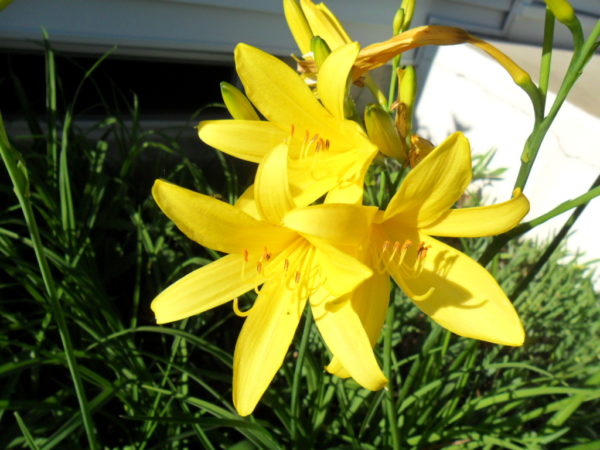
Sometime in the decade after we built here in 1963, my father acquired a later-blooming daylily, typically open in mid-late July. Deepest orange-red, almost brown, with a starry yellow throat, we never knew its name, but called it “flame lily”. Just last year I saw it at the display garden of House of Lilies, my local daylily purveyor, and was able to finally ID it as “Sammy Russel”. That lily gradually proliferated its way across the yard, emerging in several foundation plantings which I moved into the new bedding gardens in 2019, creating a large arc of glorious summer color. Decades ago I took some with me to Philadelphia, from where it spread to several locales, including a friend in West Chester, and has just come full circle, with additional divisions given back to me by him and now readjusting themselves to the south slope of the sand mound.
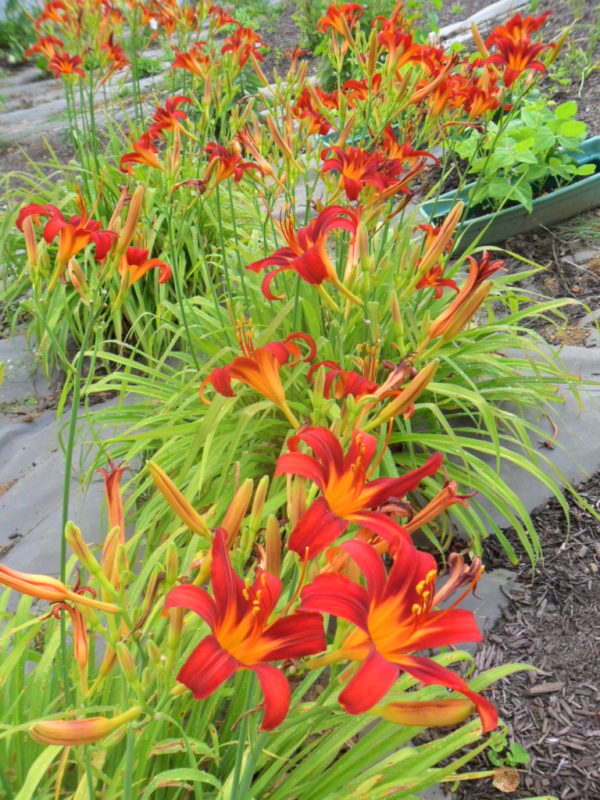
There have been three more daylilies introduced over the years, names unknown. I bought them for my parents’ anniversary in the mid- ‘90s, and they planted them in the wildflower garden. One was medium yellow, one bicolored pale yellow and pastel maroon, and one dusty burgundy. Alas! When the sand mound was installed in 2010, much of the old wildflower garden was lost, including the burgundy daylily, but I had the two remaining brought inside the fence in 2019 and they are now thriving.

But these heirlooms are just the tip of the daylily iceberg! In the fall of 2019, we planted twenty from Brecks, and last autumn installed another twenty from House of Lilies. These began to open in early June, and now, in mid-July, are in full swing, with several varieties budded and still to open. They are divided into two primary planting areas, one on the west side of the house, and another in the east. The twenty from Brecks were actually two identical sets of ten, so I split them evenly side to side (or so I thought! I keep finding where I inadvertently doubled up, but at least they’re not side-by-side), and now, in their second year, they are very vigorous, with multiple scapes (that’s lily-speak for “flower stem”) sporting masses of buds. Their names I know by heart, but the twenty new ones from House of Lilies are each unique, and not all their names have yet penetrated my noggin in their first year here, so I need to make frequent reference to my “cheat sheet” charts.

As the name implies, individual daylily blossoms last for just a day, so if you snooze, you lose! It’s become my practice to go out, camera in hand, soon after sunrise to capture the latest arrivals for posterity. Like any proud parent, I like to be there for the births of my children, but the weather doesn’t always cooperate. One day in late June I didn’t get to the west bed due to showers, and the next morning was so distressed to find a spent blossom on a daylily that hadn’t previously bloomed – I had missed my new baby’s premiere! But when I checked its nametag, I had to smile – the elusive bloomer was “Chance Encounter”! Apt moniker!

We’ve since become acquainted, and a host of others besides. I tend to go for bold colors, or ones with dramatic “eyes”, the term for a central flare of alternate color across the petal midriff, or “throats”, contrasting colors at the flower’s center. The first-years are naturally not as filled-out as the more established plantings, but are giving a good show of their potential, and I couldn’t be more pleased.

Daylilies with staggered bloom times are like opening a new wrapped present every day; until that first bud unfurls, you’re never really sure what you’ll get. Three bright-eyed lovelies that grace my garden include “Dainty Eyes”, a smaller-flowered lily in medium yellow with rose-red “eye shadow”; “Baby Moon Café”, creamy butterscotch with maroon markings; and “Exotic Love”, a vivid yellow-mustard with a burgundy-brown ring. Next in tone would be “Hungry Eyes”, cinnamon-peach with a muddy purple eye and rim to match, followed by “Siloam Jim Cooper”, rosy pink with deep pink banding. Darkest is “Storm Shelter”, with ruffled petals medium purple at the rim, deeper purple at the eye, and offset by a narrow throat of lime green. But the queen of my eyed daylilies has to be “Inkheart”; this creamy yellow-ocher wonder has a broad inky purple eye across huge blossoms, more than 7” in diameter, by far the largest lily in my collection.
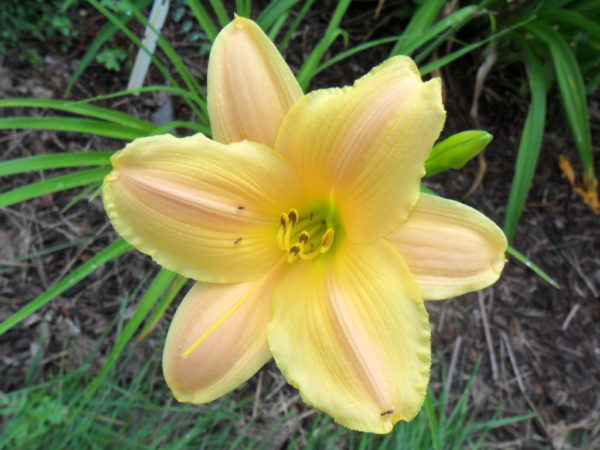
In contrast, “Little Rainbow” is one of the smallest, with blooms that are barely 4” across. “Little Rainbow” was a surprise, a mistake by my grower, who inaccurately identified it as lavender “Water Witch”, which I had ordered and was growing cheek-by-jowl right next to it. This is a daylily I would never have chosen, but I’ve come to really appreciate its subtle beauty, with slightly ruffled petals in pale yellow that blush to pastel peach at the midrib. In softer light the edges appear almost white, providing a rainbow-like transition of color in each petal. This was a happy accident!
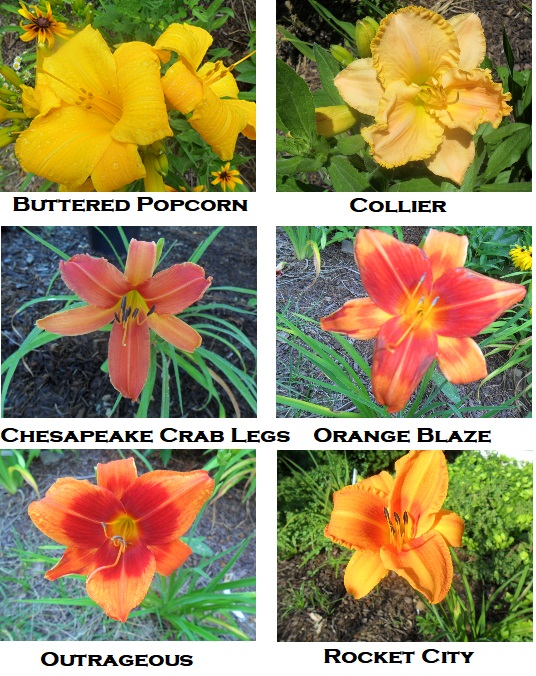
We can group the rest by color palette. I’ve always been partial to fire tones (perhaps my Leo proclivities), and I have a wide range of daylilies in that spectrum. Most of my yellow lilies have eyes, and have already been pictured. A notable exception is the aptly-named “Buttered Popcorn”, which seems to glow incandescently from the mixed border; it really is the color of that fake butter they use at the movies. Its blossom size rivals “Inkheart”, but the recurved petals make it look somewhat smaller. “Collier”’s ruffled edge and pale butterscotch coloring entice yet soothe the eye, but “Rocket City” makes no bones about its flare, with a golden-tangerine color profile. “Chesapeake Crab Legs” is one of my favorites, with its striking petal midline of yellow and a tone that truly matches its boiled crustacean namesake. But for drop-dead gorgeous it’s hard to beat “Orange Blaze” and “Outrageous”, both bright orange with burnt red-orange centers that set the border aflame.
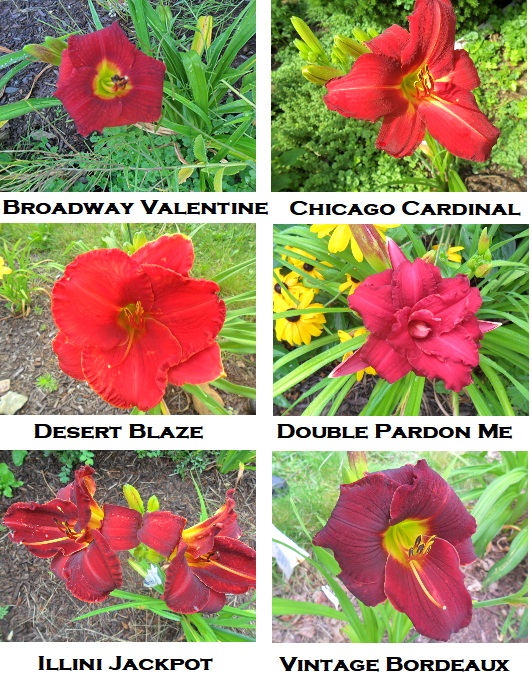
I probably have more reds than anything in the daylily collection. These vary from the vivid firetruck red of “Desert Blaze” to the burgundy-black shades of “Vintage Bordeaux”. “Chicago Cardinal” is brick-red with a tentative yellow-white midline, while “Illini Jackpot” doubles down on this color scheme, with petals a tone darker and a midline a tone brighter. “Double Pardon Me” is another smaller-flowered variety, the only double lily in the collection, profuse with rose-burgundy petals, and “Broadway Valentine”, another petite blossom, red-shifts toward burgundy-purple.
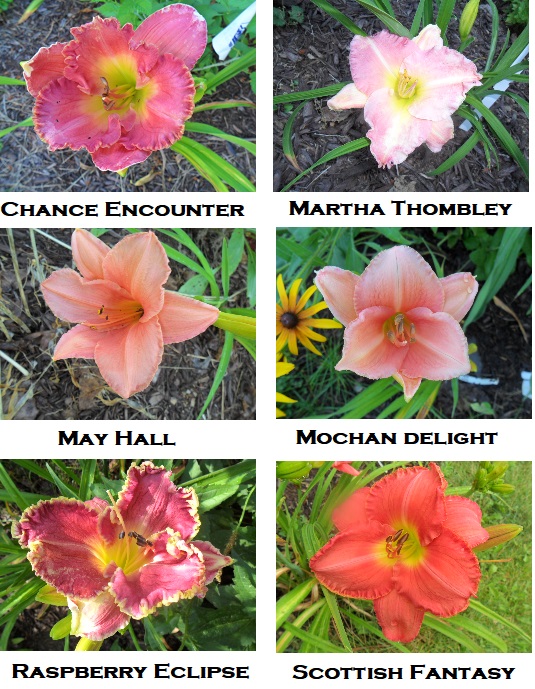
Naturally, add a bit of white to red and you get pink, in its plethora of shades from coral through rose and magenta. “May Hall” and “Mochan Delight” are virtually identical in color, with pastel coral-pink petals and a similar size. But “Mochan Delight” has a whitish gloss, and is distinguished by a thin blue-gray petal midline, and anthers of a similar color, where “May Hall” inclines slightly toward peach and is uniform in tone. “Scottish Fantasy” is another larger-flowered variety, resplendent in slightly reddish pinky-rose, with a dramatic yellow-green throat. “Raspberry Eclipse” (which first opened for me last year on the very day of the June Solar Eclipse) is extremely exotic, with deep rose coloring overall, but accented by a deeply ruffled yellow-white trim and a striated lemon-lime throat that bleeds into the petal. “Chance Encounter” has a similar palette, but with a brighter pink and a less showy edge, with its deepest throat a pale green blushing to medium yellow as it rises. “Martha Thombley” is hard to categorize – it might be pink, and then again, it might be lavender. However you view it, a striking creamy white midrib flare cross each petal marks it as a standout in the early summer border.

Of course, daylilies aren’t the only thing on the property – there are Asiatic lilies, too! Prominent among these is “Forever Susan”, the earliest to bloom, starting in early June. Unlike daylilies, Asiatic lily flowers remain in bloom for much longer than a day, up to a week, if weather conditions permit. So though they tend to have less buds over all, their blooms are much more impressive and eye-catching in clusters of blossom. “Forever Susan” had proliferated impressively during its winter slumber, expanding into large clumps, and in total, gave me five weeks of consistent bloom, extending into mid-July.
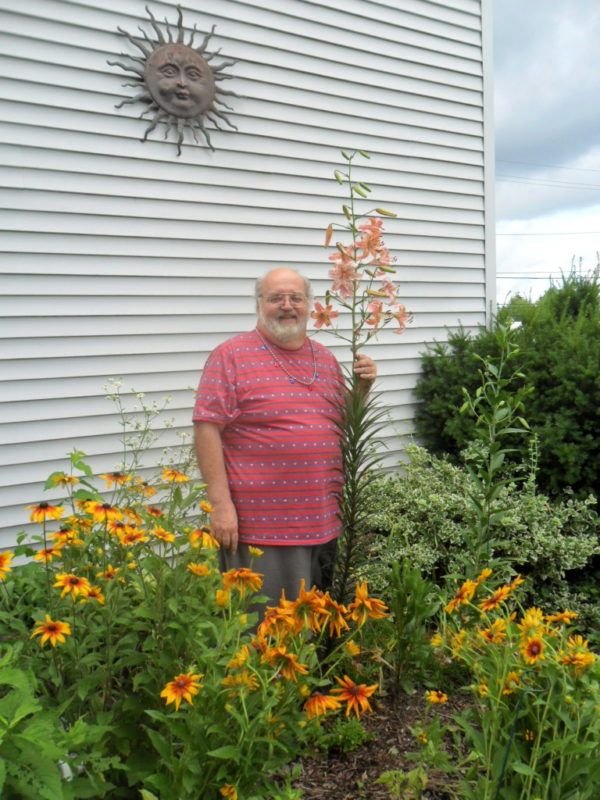
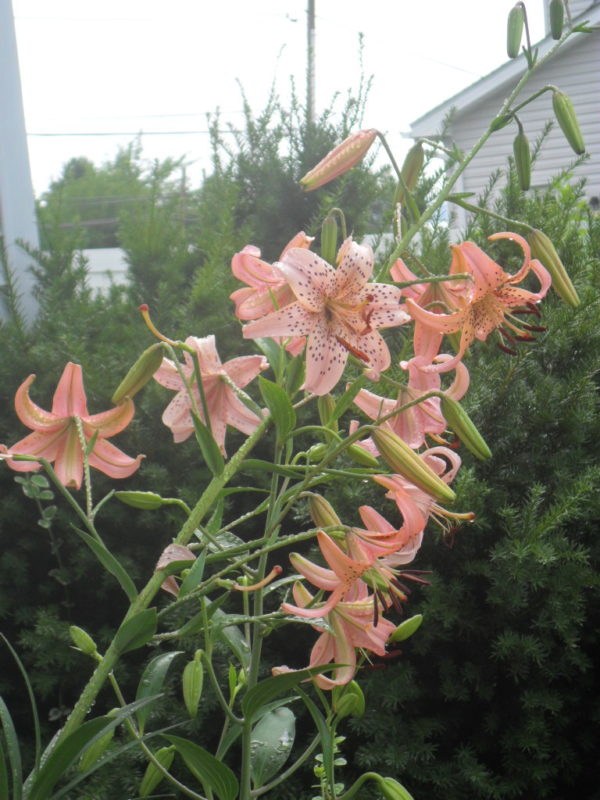
I also have several “Stargazer” Asiatic lilies, and there was a stand of Tiger lilies inherited from my parents, which has been on the property for forty years and continues to thrive. These are just beginning to pop in mid-July, and will shortly be joined by Stargazer; both will bloom well into August. But the most impressive Asiatic I have is the well-named “Pink Giant”. Towering over 8 feet, this lily makes quite a statement, though its coloring is rather pale pink freckled with brown. One of the bloom heads which had more than three dozen buds, has been in flower for over three weeks, with about a week to go before it’s finished. “Pink Giant” didn’t spread as much as “Forever Susan”, but two of three plantings do have one or two small side-stems, each with a pair of buds. In time I have little doubt they will form as huge a mass as the Tiger lily.

That’s a lot of lilies, but they form only a small part of the garden goodies as a whole, with July the dominant month for bloom. One plant I’m especially proud of is my purple bee balm. This was an import from my Philadelphia garden, with the first planting on the property a gift to my parents more than a decade ago. When I moved here in 2020, I brought another four stands with me, small plantings which spread rapidly.

But there was a problem. Bee balm forms a multi-blossom flower head, which develops while encased in a set of sepals. Once these break, the individual bloomlets will start opening – they each resemble cardinal flower or lobelia in shape, but clustered en masse on the bloomhead rather than distributed along the stem. A few years ago, I noted that dad’s flowers were empty when the sepals opened, and the only “blossom” he got was the purple-tinged retracted sepals.

Well, it wasn’t my property, and I rarely saw them in bloom, so I didn’t give it much thought. Until last year, when the same phenomenon appeared on my transplants! Hours of googling yielded limited results – others had experienced the problem, but no one knew what was causing it. Until I found one gardening thread which listed the culprit as the larval form of the horsemint moth, which lays its eggs inside the bud before it opens. The caterpillars hatch and eat out the entire flower before it has a chance to bloom! My bee balm was still “blooming” when I found this info, so I took a closer look, and sure enough, I was seeing black specks of worm dirt across the sepals, and one or two small, whitish caterpillars with pink and green markings, just as described in the thread. Unfortunately, while the problem had been identified, there were no solutions proffered.
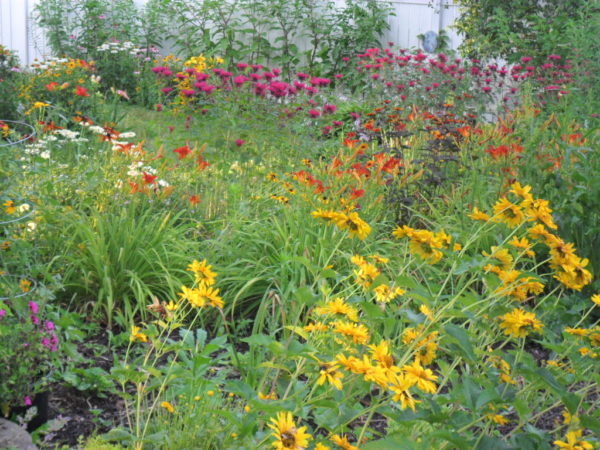
I decided to try spraying each bud with Bt as it opened. Bt is a safe biologic control, non-toxic to anything but caterpillars. It doesn’t kill them outright, it’s a natural bacillus which, once ingested, bloats the intestinal tract and causes the worm to feel full and stop feeding. Within days they die of starvation. The benefit is that it affects no other insects, and won’t even harm birds or other wildlife if they eat an infected worm.
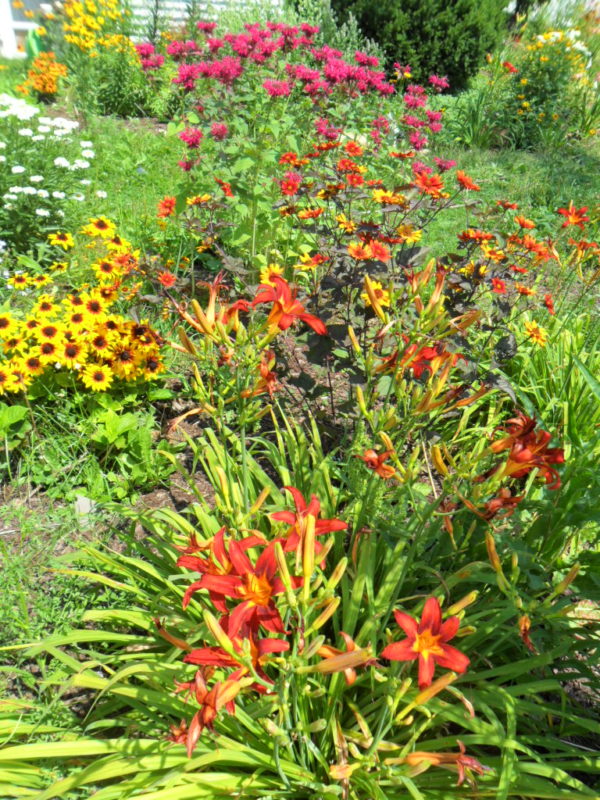
The downside is the precision and specificity with which it must be applied. It won’t work until the sepal has actually started to break, and you need to spray every bud, which all open randomly once the show begins. As with most vegetation sprays, it washes off with rain, so anytime there’s a shower, you need to refresh the entire plant, even previously treated buds.
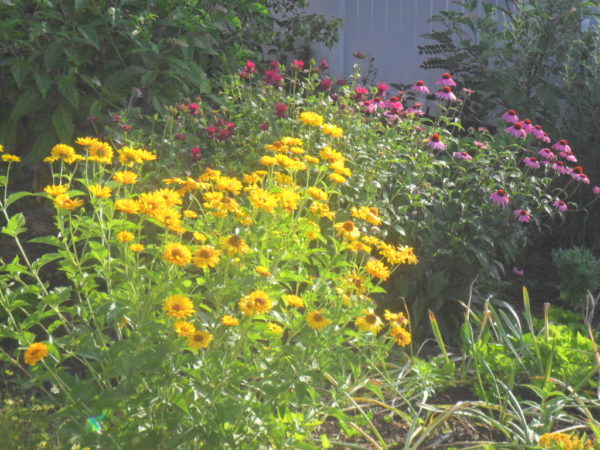
Man, I don’t know when I’ve worked so hard for a flower! But as you can see, the Bt was effective, and the results were well worth the effort. I have a lot of yellow in the garden, and these islands of purple-red add a much-needed contrast. With the pink-purple of thistle, the lavender-pink of purple coneflower, the red-orange of heliopsis “Bleeding Hearts”, the red-brown of Sammy Russel daylily, the white-yellow of Shasta daisy and the white of Queen Anne’s Lace, there’s a full palette of summer color.
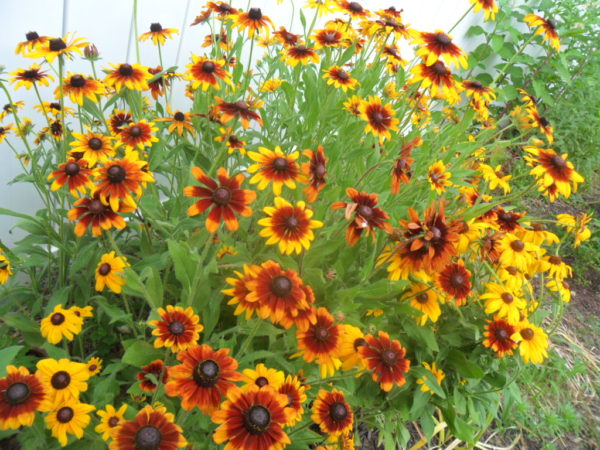
The garden is rife with daisy-like flowers just now. My folks had several stands of rudbeckia-type plants, which over the years cross-bred into a myriad of colors, from the classic bright yellow with brown mounded center of the Brown-eyed Susan to truly bizarre strains combining red, yellow and orange, even a rusty brown variety. These have always self-sown liberally in the foundation beds where they were confined, but now that the entire yard is garden, the world is their oyster, and they have started their slow but inevitable conquest of the property.

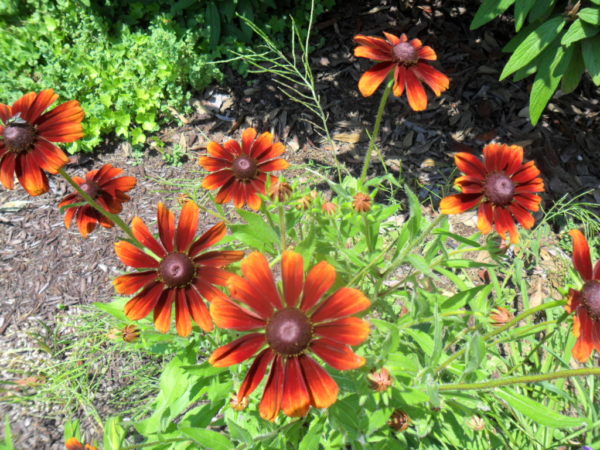
That’s fine by me; they’re prolific, long-lasting bloomers and I enjoy seeing the new color combinations they come up with yearly. They also make a great cut flower for arranging. Other favorites in the daisy line include the standard yellow heliopsis, another sun-lover with a long bloom life, whose flowers cure nicely for dried bouquets. I have six plantings of these, and I see they have begun to self-sow also.

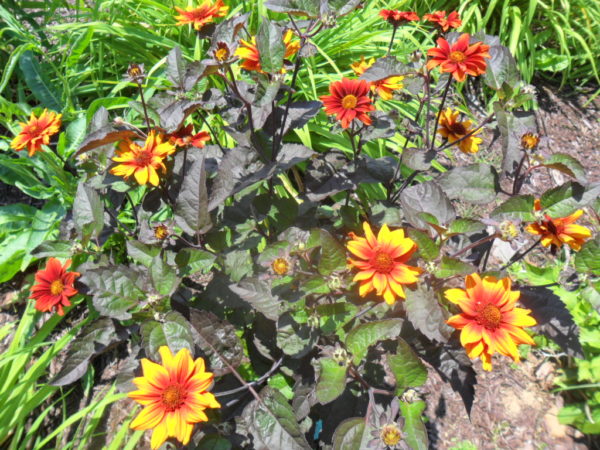
Echinacea is another staple of mid-summer, and a real favorite with pollinators and birds alike. AKA “coneflower”, the original is termed “purple”, though it’s really more of a pink in color; tall central cones in varying shades are ringed by a single row of long, colored petals, somewhat drooping. Hybridizers have created a wide array of choices, and I also grow white, orange, pale coral-pink and reddish varieties, most in the mixed borders with rudbeckia and daylily. Popular right now is “Cheyenne Spirit”, which opens deep red-orange, then fades to a shade closer to burgundy. I have three plantings, which are all fairly small, but hanging in there.
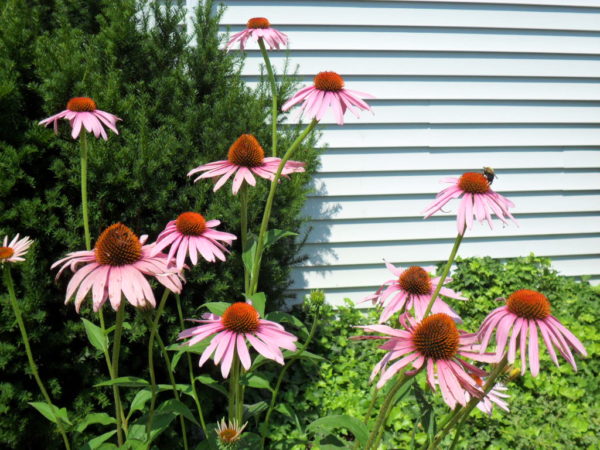
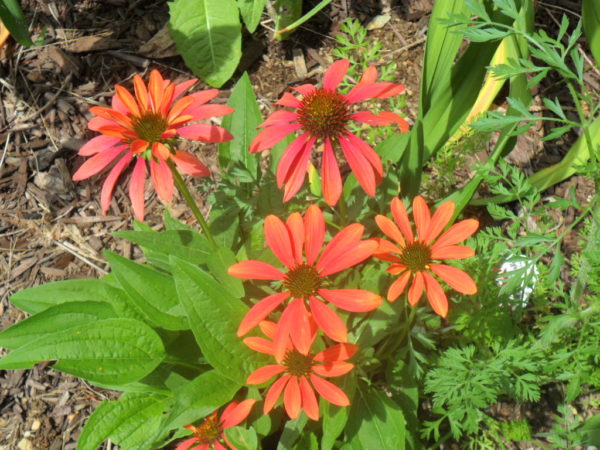

Blue daisy, tickseed and coreopsis were at their best last month, but rebloom regularly all summer. Blue daisy, actually in the aster family, is dotted with baby-blue blooms that turn down the garden heat from all the fire tones. I have a variety of tickseed, some yellow, some banded with red, some fully red-burgundy.


Last year I planted three types of crocosmia, an unusual flower with iris-like foliage that sends branched spikes of flowers blooming bottom-to-top, replete with small trumpet-shaped blossoms. Unfortunately, only one variety thrived, “Lucifer”, whose fire-red blooms light up the south rim of the sand mound. A medium orange variety never did come up, and the pale-yellow strain died out almost completely over the winter, with just two plants of 8 remaining.
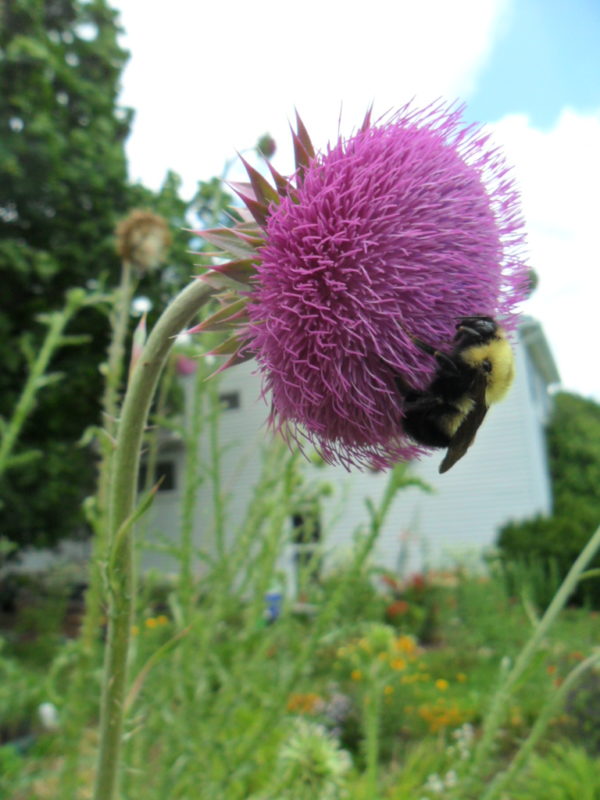
Of course, as with any season, it’s not just the intentional plantings which add interest and diversity. I always allow a few of the tall field thistles to prosper; their height and stark structure add dimension to the landscape which nothing else equals, and goldfinches love their seeds. Right now, Queen Anne’s Lace, AKA wild carrot, is proliferating widely from the three plants I allowed to grow last year. It’s delicate, fernlike foliage is topped in flat, saucer-like disks of minuscule white blossoms, and I’m trying to confine them to several mass groupings, with solitaries here and there where help is needed, but it’s an endless task to thin their multitudinous offspring, now they’ve become established.
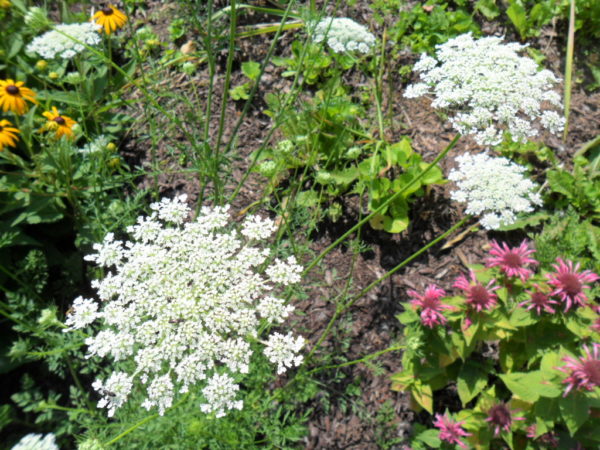
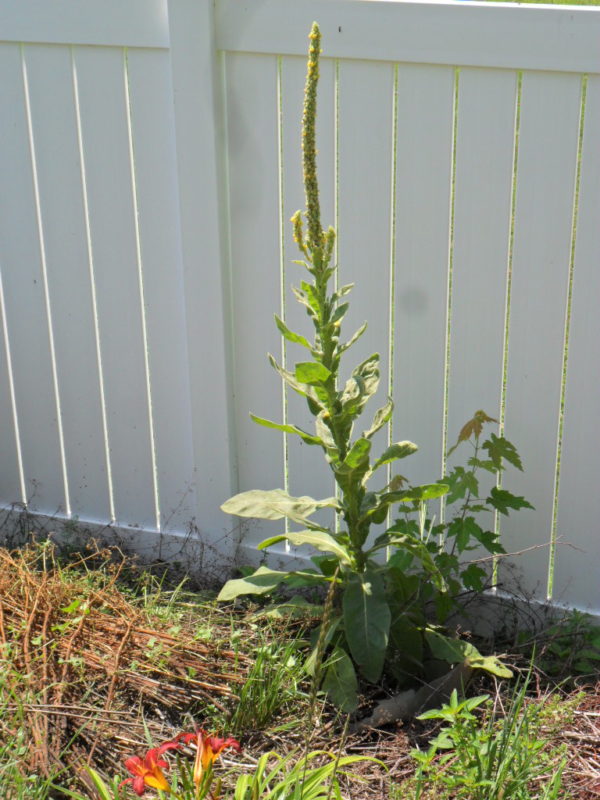
I have another mullein this year; unfortunately, my strain is annual, so I have to rely on self-sowing if I want it to return, which I most definitely do! Grey, fuzzy, almost lambs-ear type mounds of foliage send one huge vertical spike that is topped with bloom heads as much as two feet in length, with small yellow flowers clustered close about the stem. Unlike most plants with these types of blossom arrangement, the buds don’t open in any particular order, but randomly, which probably gave rise to its common name of “witch’s candle”, for the almost flickering effect of the floral taper, rising a good yard above most other wildflowers in the field.

But if I have a dominant crop among the wild plants, it’s got to be pokeberry. These massive behemoths have sturdy purplish stems and broad pinkish-veined foliage, standing a good six to eight feet or more when mature. Their bloom is understated, strands of small white starlike flowers, which are unusual in that each discloses a small green center that will become the fruit, as soon as it opens. These will plump to medium green berries about the size of a blueberry, which color to dramatic purple-black, and the birds absolutely adore them! Which is why I have a full line of these monsters along the eastern fence as soon as you come in the gate, from birds roosting on the fence after their gorging repast and pooping out the seeds.

These top the list of summer wildflowers, but there are large stands of aster, white snakeroot and goldenrod warming up in the bull pen for their autumn premiere, and my lovely purple-violet Michaelmas daisy has returned outside the gate, much more vigorous than last year.
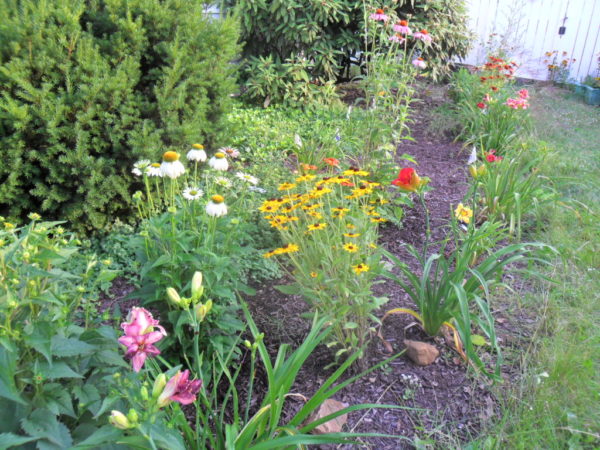
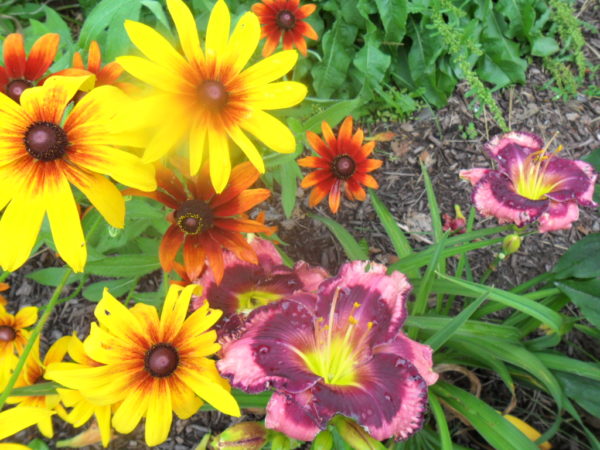
One last point of note: the shrubs. Many of these are spring bloomers, but hydrangea holds pride of place in the summer and early fall. I planted four varieties of hydrangea last year, three oakleaf and one arborescens. Only one of the oakleaf has bloomed, “Pee Wee”, and so has the arborescens, a variety called “Annabelle”. As its name implies, Pee Wee is a dwarf variety, about 4 feet by 3 feet at maturity, whereas other oakleaf hydrangeas can reach 8 feet or more in height. Its elongated flowers start out pale green, then blanch to pure white.


The reason for the lack of blooms this year could be immaturity, or might be weather-related. Oakleaf hydrangeas bloom on “old wood”, and set their buds in the fall. They’re winter-hardy, but if a cold snap comes in late spring, after the buds have started to swell, as happened this year, they can freeze out. The arborescens varieties, on the other hand, bloom on new wood, fresh spring growth, and my Annabelle sports 8 lovely white clusters of bloom. I acquired a fifth hydrangea just a few weeks ago, “Queen of Hearts”, another oakleaf type whose blossoms fade to pale pink as summer wanes, but it has no buds as of yet. Hydrangea flowers often dry nicely and may be kept for bouquets long after their season has ended, though they do become brittle and shatter-prone in time.

As July wanes, so too will the garden. Its early summer exuberance will be replaced by a more sedate version in August – still lovely, still varied, but with less verve and panache. But for now, it’s time to pluck spent daylily blossoms in the cool of the morning, sit quietly with a good book and an iced coffee in the shade of the paper birch at noon, or watch the fireflies come out to play in the humid evening air. In short, time to just be…


4 comments, add yours.
Karen
Despite some of the challenges you mention you have a beautiful, colorful, and lush garden. I’m seeing some of these flowers for the first time. Thanks for sharing.
Alexa
The photos are amazing and your commentary is superb for a vicarious experience of appreciating the garden. Thanks for sharing it.
Elsa
WOW!! Eye popping. I also love lilies and have a garden full of them. But I can see I’ve got far to go and much to learn!
Laurien
I enjoyed these photos of your garden so much, Alex! It’s funny that we live on opposite sides of the continent but share many of the same plants, including mullein wildflowers and an Annabelle hydrangea! It’s so nice when plants propagate like your Sammy Russell did so you can share with friends! I loved Inkheart and Little Rainbow too, but was completely bowled over by Pink Giant! I’ve never seen a lily so tall and I was glad you included a photo of the garden hobbit, lol! So cool Raspberry Eclipse opened on an eclipse! And great that you used environmentally friendly biologics to successfully deal with your bee balm problem. I hope you really enjoy your summer garden, Alex, as you’ve worked hard for it. Great job! Thanks for sharing!